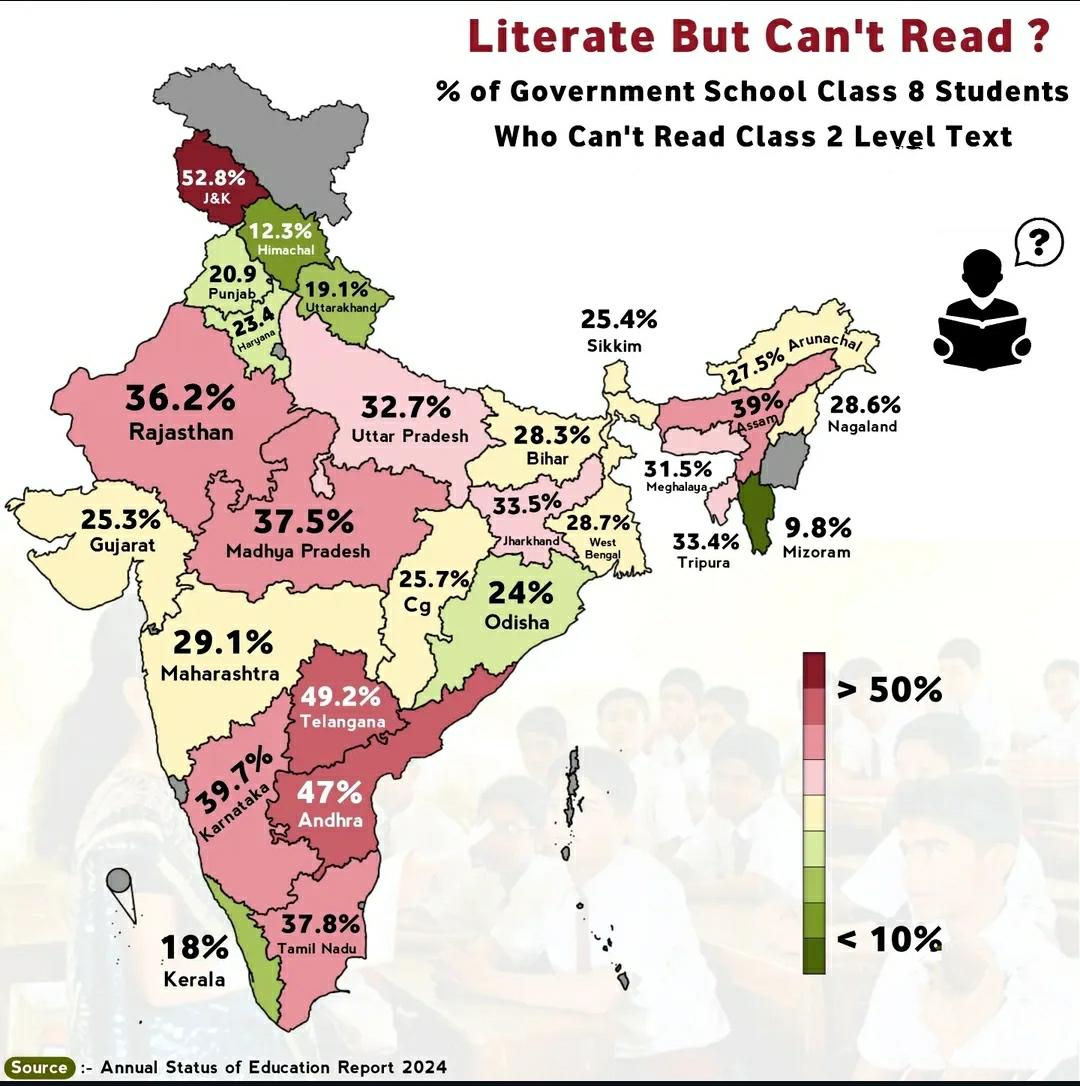Map of Students Who Can't Read Grade 2 Text in India


David Chen
Data Visualization Specialist
David Chen is an expert in transforming complex geographic datasets into compelling visual narratives. He combines his background in computer science ...
Geographic Analysis
What This Map Shows
This map highlights a critical issue in India's educational landscape: the percentage of students who are unable to read grade 2 text. It provides a geographical visualization that breaks down literacy challenges across different states and regions, revealing stark disparities in educational outcomes. Each state is color-coded to indicate the percentage of students struggling with reading proficiency, allowing for an immediate understanding of where the challenges are most pronounced.
Deep Dive into Literacy Challenges in India
Literacy is a fundamental skill that underpins a child's ability to learn and succeed academically. In India, the issue of reading proficiency, particularly at the grade 2 level, sheds light on broader educational and social challenges. According to the Annual Status of Education Report (ASER), as of 2022, approximately 40% of children in grade 2 cannot read a simple text. This statistic is alarming, considering that reading is a foundational skill necessary for further education and lifelong learning.
Interestingly, the ability to read at grade level varies significantly across states. For instance, states like Kerala and Tamil Nadu tend to have higher literacy rates, with many students demonstrating adequate reading skills. In contrast, states such as Uttar Pradesh and Bihar struggle significantly, with a much higher percentage of students failing to read at grade 2 level. This disparity raises important questions about the quality of education provided in different regions, the availability of resources, and the socio-economic factors at play.
Have you noticed that regions with better access to educational resources, such as trained teachers and adequate learning materials, often show higher literacy rates? This correlation is evident in the data. In urban areas, where infrastructure and educational institutions are more developed, students typically perform better in reading assessments compared to their rural counterparts. This difference highlights the ongoing challenge of educational equity in India.
Moreover, various factors contribute to poor reading skills among children. Language diversity is one significant aspect; India is home to hundreds of languages and dialects, and children may not always receive instruction in their mother tongue. This linguistic barrier can hinder their ability to grasp reading skills effectively. Additionally, socio-economic factors such as poverty, lack of parental education, and limited access to books and educational materials further exacerbate the issue.
Regional Analysis
The map’s regional analysis reveals stark contrasts in literacy rates across India. For instance, in the southern states, Kerala boasts one of the highest literacy rates in the country, with less than 20% of students unable to read grade 2 text. This success can be attributed to strong government initiatives, community involvement, and a focus on early childhood education.
In contrast, northern states like Uttar Pradesh and Bihar face daunting challenges. In these regions, over 50% of grade 2 students struggle with reading. Factors such as inadequate school infrastructure, teacher shortages, and socio-economic challenges play a significant role in these low literacy rates. Interestingly, the disparity is not just between states but also within them; rural districts often lag behind urban areas, highlighting the need for targeted interventions.
Furthermore, states like Maharashtra and West Bengal present a mixed picture. Urban centers within these states may show promising literacy rates, while rural areas struggle. Programs aimed at enhancing reading skills must consider these regional differences to be effective.
Significance and Impact
Understanding the implications of literacy challenges is crucial for India’s future. Literacy directly impacts employability, economic growth, and social development. A literate population is better equipped to participate in the workforce, engage in civic activities, and contribute to the nation’s economy. Conversely, high rates of illiteracy can perpetuate cycles of poverty and limit opportunities for future generations.
What's fascinating is that recent trends show a growing awareness of these issues. Government initiatives and NGOs are increasingly focusing on improving literacy rates by implementing innovative teaching methods, providing training for teachers, and promoting community reading programs. The National Education Policy (NEP) 2020 also emphasizes foundational literacy and numeracy, aiming to address these challenges head-on.
The future projections indicate that if current trends continue, we may see improvements in literacy rates, particularly with the implementation of targeted educational programs. However, sustained efforts will be required to ensure that all children, regardless of their background, have the opportunity to develop essential reading skills. As we move forward, addressing these disparities will be vital for fostering an inclusive and educated society in India.
Visualization Details
- Published
- September 24, 2025
- Views
- 68
Comments
Loading comments...